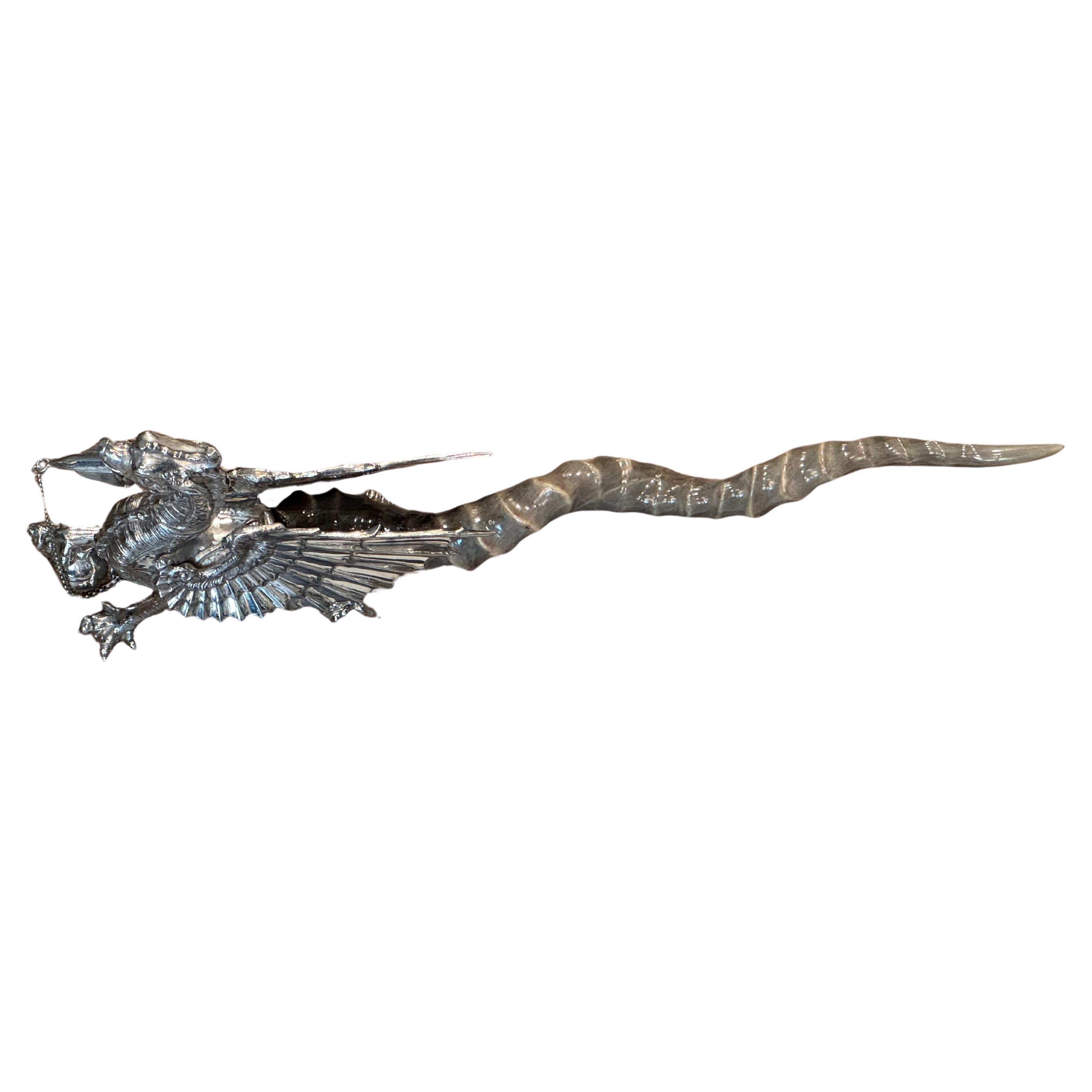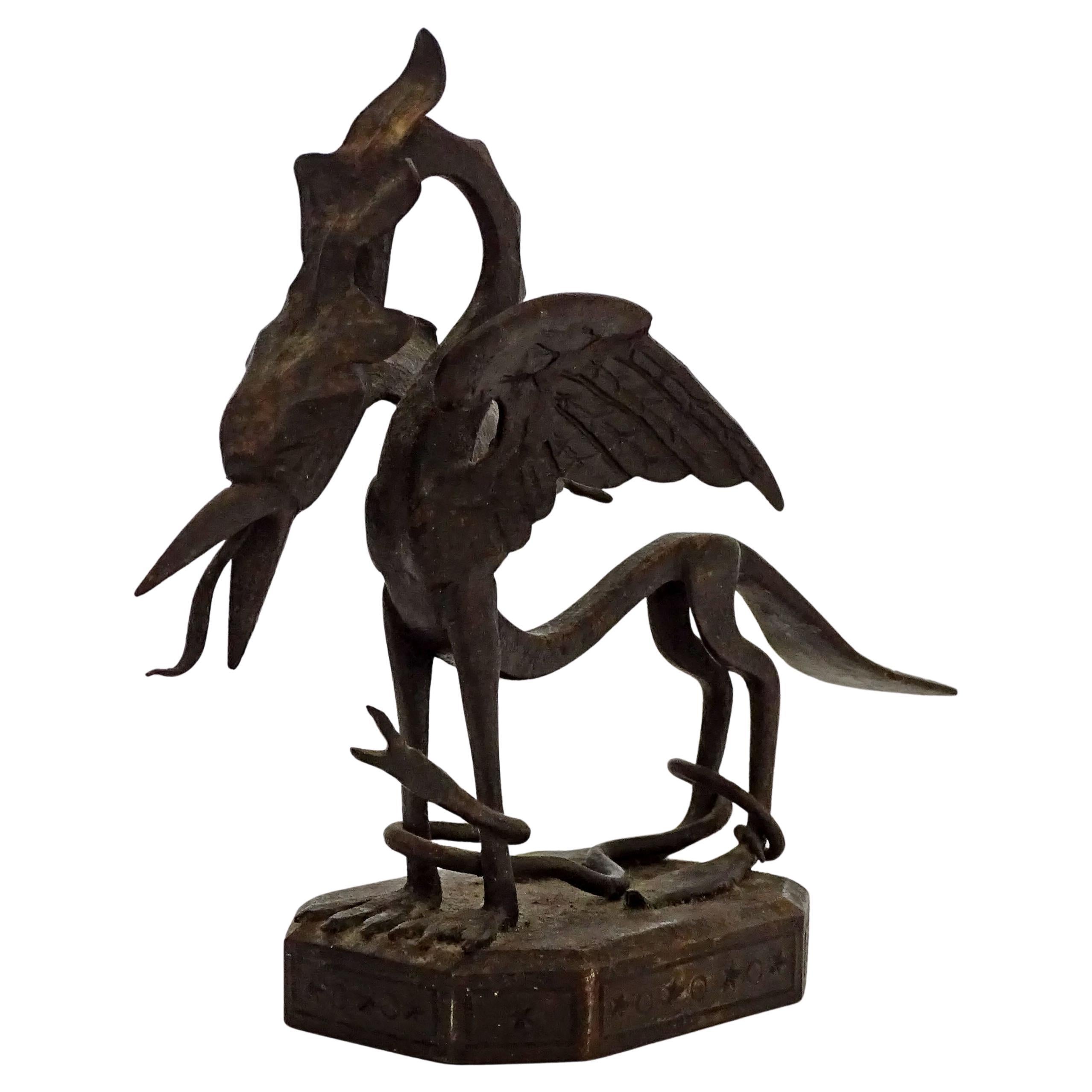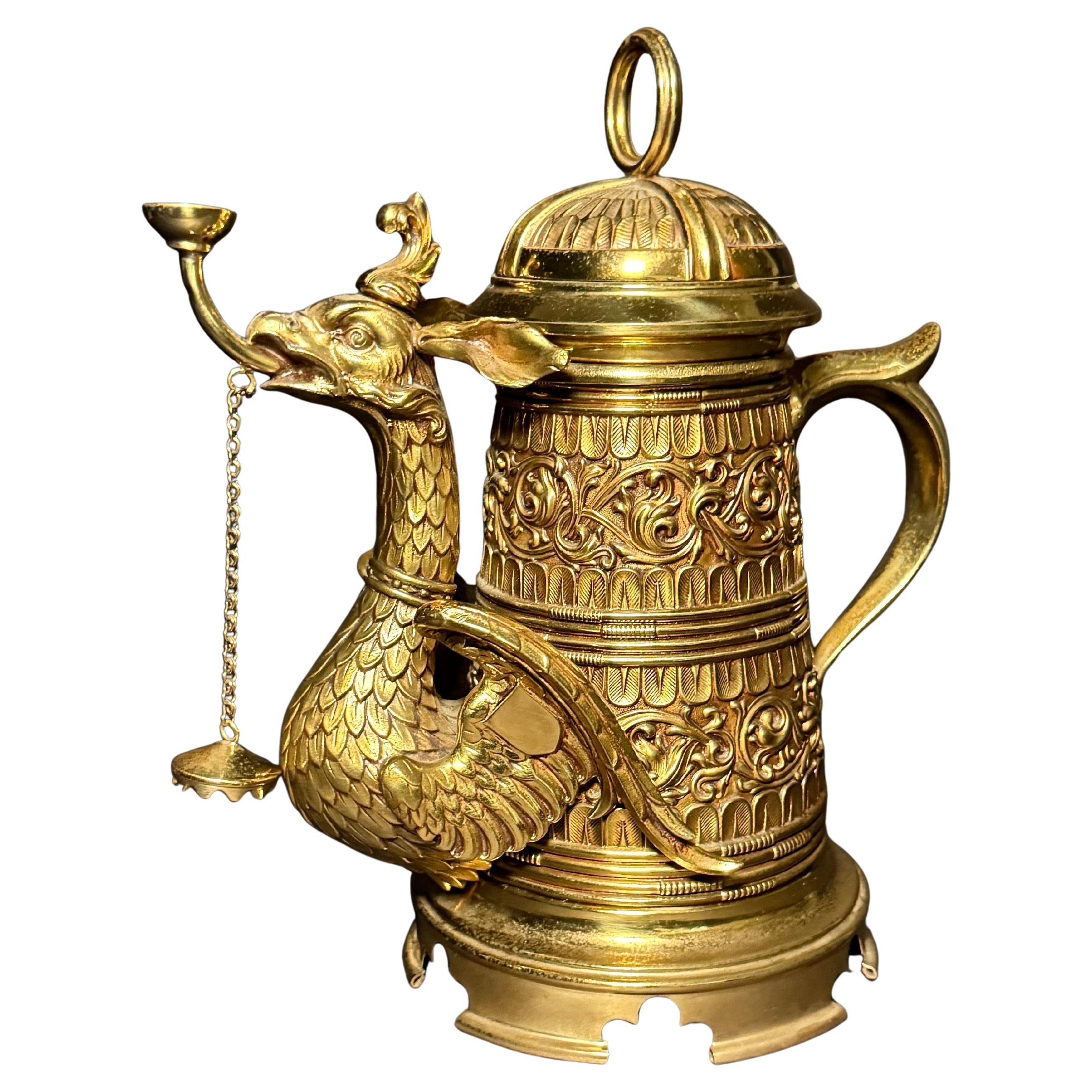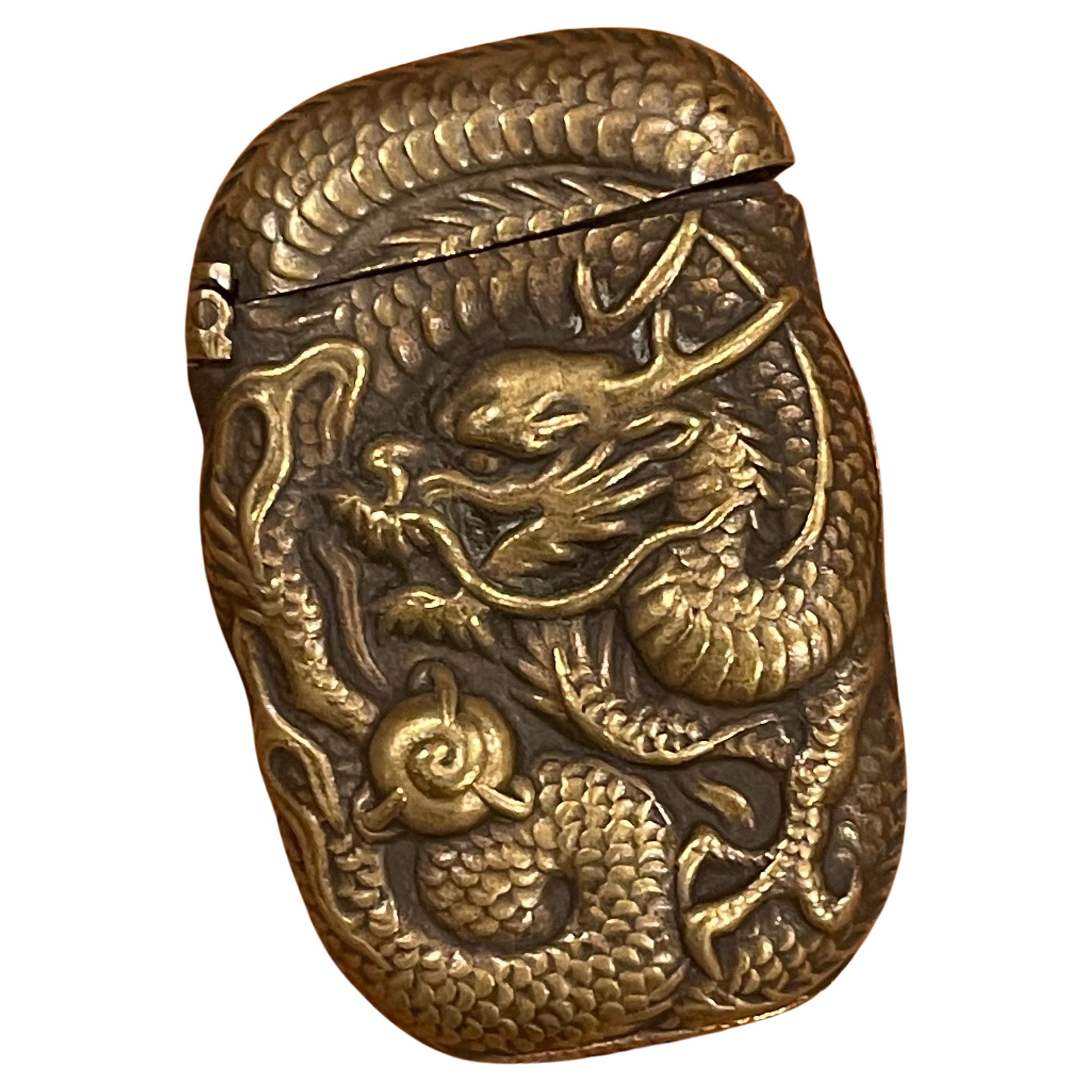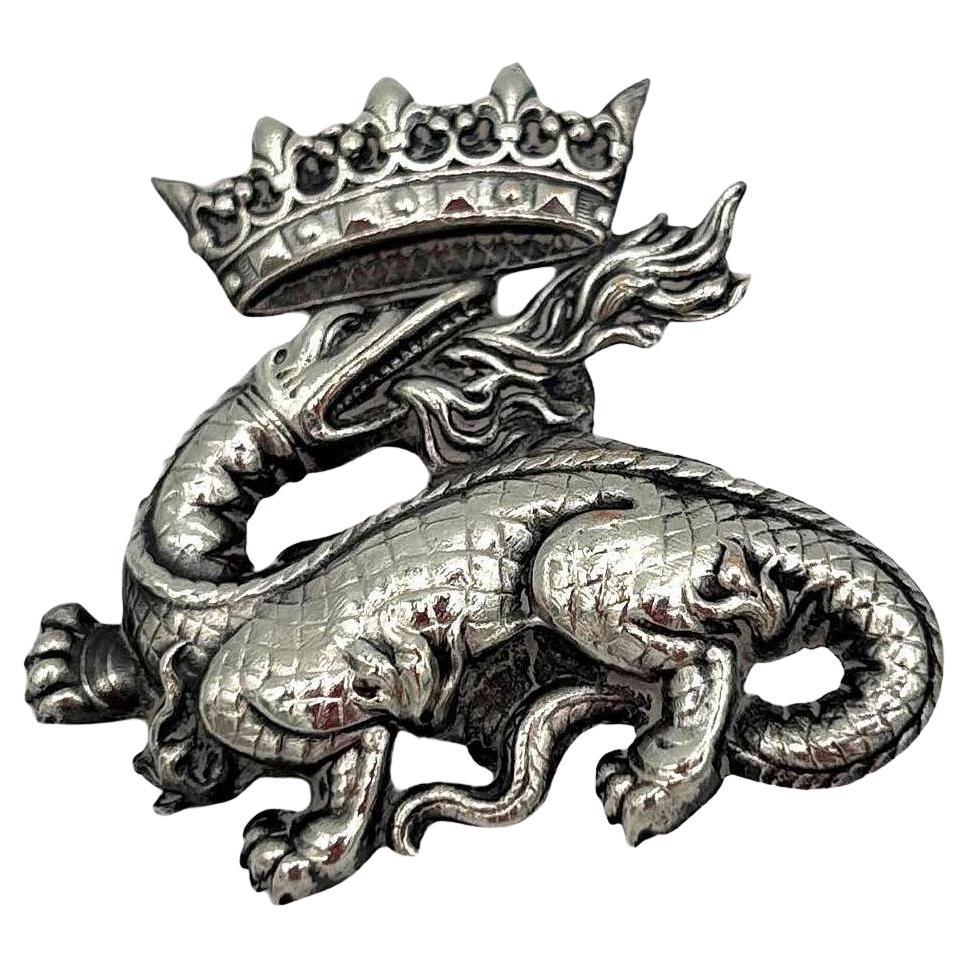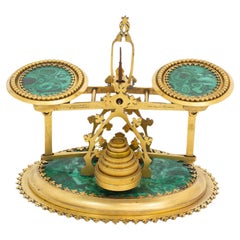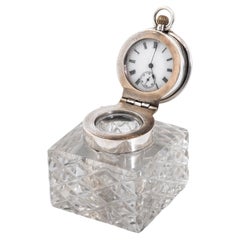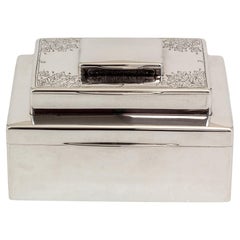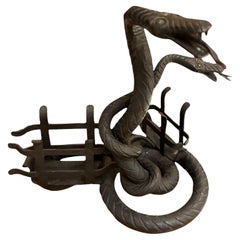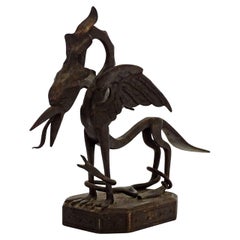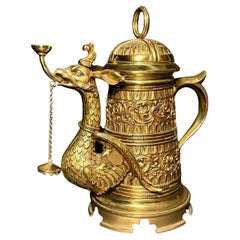Items Similar to Military Mess Dragon Table Lighter Gifted to Earnest ‘Bee’ Edwards Liverpool FC
Want more images or videos?
Request additional images or videos from the seller
1 of 11
Military Mess Dragon Table Lighter Gifted to Earnest ‘Bee’ Edwards Liverpool FC
$8,946.70
£6,500
€7,619.05
CA$12,213.95
A$13,587.52
CHF 7,122.75
MX$166,036.19
NOK 90,699.32
SEK 85,380.86
DKK 56,873.30
Shipping
Retrieving quote...The 1stDibs Promise:
Authenticity Guarantee,
Money-Back Guarantee,
24-Hour Cancellation
About the Item
Dragon Registration Number 51318
From our Silver collection, we are absolutely thrilled to introduce direct from the family a Dragon Table Lighter Gifted to Earnest ‘Bee’ Edwards. The lighter in the form of a dragon stood upon a flaming grenade with a tail formed from Blackbuck Antelope horn. The dragon stands with its mouth agape with the wick simulating the dragon breathing fire with a chained candle snuff. To the front of the dragons chest is a removable tamper in the form of an arrow flanked by the phrase “Ye Dragon of Wantley” in reference to the dragon of Wantley, a legend of a dragon-slaying knight in Whancliffe Crags in South Yorkshire. The story is told in Thomas Percy’s 1767 “Reliques of Ancient English Poetry”. Between the wings of the dragon is a unique plaque which reads “To Mr Ernest Edwards “Bee” A Real Good Friend From F.A of Wales” below the flag hallmark for Walker and Hall. The Dragon Table Lighter Gifted to Earnest ‘Bee’ Edwards dates to the first quarter of the 20th century circa 1915.
Ernest “Bee” Edwards
The military mess table lighter was presented to Ernest “Bee” Edwards by the Welsh Football Association. Unlike other versions of this stylish lighter, this version has a unique silvered plaque between the two wings. Ernest Edwards was known as “Bee” from his early days and he kept it throughout his career. In 1904 Bee became the first ever sports editor of the Liverpool Daily Post and Echo. He reported on Liverpool and Everton matches every week and had a keen following amongst supporters, many of whom speculated on which side he favoured most. He is widely credited as being the person who came up with name of “The Kop” at the Liverpool football stadium for the new terrace built in 1906. He also tested the limits of the corner kick rule with player Sam Chedgzoy being paid £2 by him to participate. Bee also came up with an idea along the lines of a Fantasy Football League and once acted as a player’s agent for player Bert Freeman who eventually signed for Everton. His career spanned over 30 years and throughout his time he kept up with new ways of communicating and new formats for sports reporting. He broadcast on local radio, he edited a weekly magazine for Vernon’s Pools then in its infancy, he interviewed footballers on Pathe Newsreel, and once appeared as a guest on This is Your Life which followed the life of Arthur Christiansen the legendary editor of the Daily Express. In the early days, his reports were sent by pigeon from the press box at Anfield or Goodison to the newspaper office in Victoria Street. Later he was the only sports reporter at Liverpool with access to a phone, and thereby was able beat his rivals to print.
The Spion KOP at Anfield
The KOP at Liverpool’s Anfield home ground has long been regarded as one of the nosiest and most passionate stands in all of football. When the sports editor of the Liverpool Daily Post and Echo, Ernest “Bee” Edwards talked to the new owners of the club, they all agreed a new stand was needed to ensure the safety of the fans. Construction started on the new stand and in the process a huge open-air embankment was created. After seeing the materials of cinder and brick the resemblance of earthwork was shaped like the Spion Kop (a famous battle in the Boer War). Edwards came up with the name in tribute for the many Scousers who had lost their lives there six years before. Edwards said at the time,“ this huge wall of earth has been termed ‘Spion Kop’, and no doubt this apt name will always be used in future in referring to this spot.”
User Instructions Inflame the wick that hangs from the mouth by using a lighter or a match. In the event the wick is dry, lighter fuel should be used, which can be purchased from any tobacconist. In order to burn the wick some fuel needs to be dripped on it, this can also be applied to its interior by removing the head. (This is also what you must do if the wick runs out in the future). Once you have unscrewed the head, you will see the remainder of the wick, which can be filled with fuel by unscrewing the head carefully. You may have to pull the wick out a little 2-3 mm from the mouth if it gets too short. Note, if it gets pulled too far out the flame will become too big. When the wick eventually runs out it will need replacing.
Silver-Plate is a term used when objects are primarily made of other metals and coated with a thin layer of silver. Often the base layer of the object is brass. The item is made the base metal and then dipped in a silver solution giving the item a silver appearance. As the object is not Solid Silver it bares slightly different hallmarks to traditional Silver and will not feature the Sterling Silver identification.
- Creator:Walker & Hall (Maker)
- Dimensions:Height: 5.91 in (15 cm)Width: 18.51 in (47 cm)Depth: 2.96 in (7.5 cm)
- Style:Art Nouveau (Of the Period)
- Materials and Techniques:
- Place of Origin:
- Period:
- Date of Manufacture:Circa 1890
- Condition:Minor fading.
- Seller Location:Northampton, GB
- Reference Number:Seller: 5015281stDibs: LU8027244919462
About the Seller
No Reviews Yet
Vetted Professional Seller
Every seller passes strict standards for authenticity and reliability
Established in 1998
1stDibs seller since 2023
32 sales on 1stDibs
Typical response time: 4 hours
- ShippingRetrieving quote...Shipping from: Northampton, United Kingdom
- Return Policy
Authenticity Guarantee
In the unlikely event there’s an issue with an item’s authenticity, contact us within 1 year for a full refund. DetailsMoney-Back Guarantee
If your item is not as described, is damaged in transit, or does not arrive, contact us within 7 days for a full refund. Details24-Hour Cancellation
You have a 24-hour grace period in which to reconsider your purchase, with no questions asked.Vetted Professional Sellers
Our world-class sellers must adhere to strict standards for service and quality, maintaining the integrity of our listings.Price-Match Guarantee
If you find that a seller listed the same item for a lower price elsewhere, we’ll match it.Trusted Global Delivery
Our best-in-class carrier network provides specialized shipping options worldwide, including custom delivery.More From This Seller
View AllAntique Brass and Malachite Scales by Halstaff & Hannaford
By Halstaff & Hannaford
Located in Northampton, GB
Malachite Base Mounted in Brass
From our Accessories collection, we are delighted to offer these Bronze Gilded Malachite Postal Scales by Halstaff and Hannaford, London. The scales ...
Category
Antique Late 19th Century English Art Nouveau Scientific Instruments
Materials
Malachite, Brass
Art Nouveau Pocket Watch Desk Inkwell
By John Grinsell & Sons
Located in Northampton, GB
The Inkwell of square shape made from glass with hand cut diamond quilt pattern to the exterior. The lid of the inkwell mounted with a Sterling Silver hinged lid is hallmarked to the...
Category
Early 20th Century English Art Nouveau Inkwells
Materials
Silver, Sterling Silver
Tortoiseshell and Silver Stationery Box William Comyns
By William Comyns
Located in Northampton, GB
Raised on Four Sterling Silver Scrollwork Legs
From our Writing Box collection, we are pleased to offer this Tortoiseshell and Silver Stationery Box by William Comyns. The Stationer...
Category
Antique Early 1900s English Art Nouveau Desk Sets
Materials
Silver
Triple Tiered Silver Smokers Compendium by Goldsmiths and Silversmiths Company
By Goldsmiths & Silversmiths Co. Ltd.
Located in Northampton, GB
Goldsmiths and Silversmiths Company
From our Silver collection, we are delighted to introduce to the market this Solid Silver Triple Tiered Smokers Compendium. The Silver Smokers Co...
Category
Antique Early 1900s English Art Nouveau Tobacco Accessories
Materials
Silver, Sterling Silver
Rene Lalique Coq Houdan Car Mascot
By René Lalique
Located in Northampton, GB
Original Rene Lalique Car Mascot
From our Lalique collection, we are thrilled to offer this Rene Lalique Coq Houdan (Chicken) Car Mascot. The Mascot from ...
Category
Early 20th Century French Art Deco Glass
Materials
Glass
Original Art Deco Rene Lalique Faucon (Falcon) Car Mascot
By René Lalique
Located in Northampton, GB
Original Rene Lalique Car Mascot #1124 Bouchon de Radiateur Faucon
From our Rene Lalique collection, we are delighted to offer this stunning French Rene Lalique Falcon...
Category
Early 20th Century French Art Deco Glass
Materials
Glass
You May Also Like
Antique Sheffield Electroplated Table Cigar Lighter, Circa 1900
By John Edward Bingham (Walker and Hall)
Located in West Hollywood, CA
Antique Sheffield Electroplated Table Cigar Lighter
This unique and collectible piece features a dragon design with an unscrewing head, meticulously crafted by Walker & Hall around 1900. The body is made from the horn of an Indian blackbuck antelope, adding to its exotic charm and historical value. This Sheffield electroplated cigar lighter is not just a functional item but a statement piece for any collector or enthusiast of antique smoking accessories.
Category
Antique Early 1900s British Sheffield and Silverplate
Materials
Silver, Sheffield Plate
Card holder dragons, 1900 , Style: Art Nouveau, Liberty, jugendstil
Located in Ciudad Autónoma Buenos Aires, C
We have specialized in the sale of Art Deco and Art Nouveau and Vintage styles since 1982. If you have any questions we are at your disposal.
Pushing the button that reads 'View All ...
Category
Antique Early 1900s French Art Nouveau Abstract Sculptures
Materials
Iron
Italian 1920s wrought iron dragon and snake paperweight
By Carlo Rizzarda
Located in Milan, IT
Splendid Italian 1920s wrought iron dragon and snake paperweight.
Category
Vintage 1920s Italian Mid-Century Modern Paperweights
Materials
Wrought Iron
Fine Antique Bronze Dragon Form Cigar Holder/ Lighter Lamp
Located in Norwood, NJ
This is an extraordinary and decorative Victorian period Dragon / Griffin form cigar lighter tankard, Acting as table top cigar holder/humidor.
Prussian, (Austrian), late 19th centu...
Category
Antique Late 19th Century Austrian Victorian Tobacco Accessories
Materials
Brass, Bronze
Antique Petite Bronze Dragon / Griffin Pattern Repousse Match Safe / Vesta
Located in San Diego, CA
Antique petite bronze dragon / griffin pattern repousse match safe / vesta with an ornate all-over design on both sides, circa 1900s. The match holder measures 1.75" x 1" and is in v...
Category
Early 20th Century American Sterling Silver
Materials
Bronze
$520 Sale Price
20% Off
French Crowned Dragon Silver Plate Pendent Heraldic King Francis 1st Emblem
Located in Van Nuys, CA
This vintage French crowned salamander pendant, crafted in silver circa the 1900s, embodies the elegance of French monarchy-inspired design. The intricately detailed salamander, a hi...
Category
Antique Early 1900s American Late Victorian Collectible Jewelry
Materials
Silver
$151 Sale Price
44% Off
More Ways To Browse
Antique Lighters Lighters
Tobacco Can
Unique Lighters
Antique Walkers
Antique Hand Press
Phone Number
Military Box
Metal Dragon
Walker And Hall
Antique Dragon Table
Used Furniture In Liverpool
Chain Side Tables
Antique Furniture Liverpool
Ancient Brick
Used English Horn
Lighter Sterling
Post Horn
Antique Tobacco Signs
